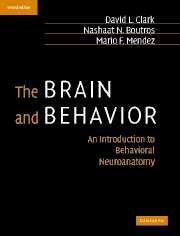Book contents
- Frontmatter
- Contents
- Preface
- 1 Introduction
- 2 Gross anatomy of the brain
- 3 Histology
- 4 Occipital and parietal lobes
- 5 Temporal lobe – neocortical structures
- 6 Frontal lobe
- 7 Basal ganglia
- 8 Diencephalon: hypothalamus and epithalamus
- 9 Diencephalon: thalamus
- 10 Brainstem
- 11 Limbic system: temporal lobe
- 12 Limbic system: cingulate cortex
- 13 Limbic system: overview
- 14 Interhemispheric connections and laterality
- Index
- Plate section
- References
3 - Histology
Published online by Cambridge University Press: 25 August 2009
- Frontmatter
- Contents
- Preface
- 1 Introduction
- 2 Gross anatomy of the brain
- 3 Histology
- 4 Occipital and parietal lobes
- 5 Temporal lobe – neocortical structures
- 6 Frontal lobe
- 7 Basal ganglia
- 8 Diencephalon: hypothalamus and epithalamus
- 9 Diencephalon: thalamus
- 10 Brainstem
- 11 Limbic system: temporal lobe
- 12 Limbic system: cingulate cortex
- 13 Limbic system: overview
- 14 Interhemispheric connections and laterality
- Index
- Plate section
- References
Summary
The brain weighs between 1100 and 2000 g. It contains an estimated 100 billion neurons. The average neuron has up to 10 000 synapses. Almost one-third of this immensely complex system is dedicated to the function of behavior.
Anatomy and behavioral considerations
Two types of cells make up the nervous system: neurons and neuroglial cells. Neurons are specialized to conduct bioelectrical messages, whereas the glial cells play a supportive role.
The neuron
The neuron is the structural and functional unit of the nervous system. It is made up of four distinctive regions: the soma (nerve cell body), the dendrites, the axon, and the synapse (Figures 3.1 and 3.4). The soma is the metabolic center of the cell and contains the cell nucleus. The nucleus is centrally located in the soma, and the cytoplasm immediately surrounding the nucleus is called the perikaryon. The cytoplasm of the axon is called the axoplasm.
Most neurons have several dendrites. Each neuron has a single axon (Figure 3.2). The axon arises from a specialized region of the cell body called the axon hillock (see Figure 3.1), which is specialized to facilitate the propagation of the all-or-none action potential.
Nissl substance (rough endoplasmic reticulum) and Golgi apparatus are restricted to the perikaryon and to the base of the dendrites. They synthesize proteins for use throughout the neuron. Three classes of proteins are produced. One of these classes produced in the perikaryon includes the neurotransmitters.
Information
- Type
- Chapter
- Information
- The Brain and BehaviorAn Introduction to Behavioral Neuroanatomy, pp. 17 - 34Publisher: Cambridge University PressPrint publication year: 2005
